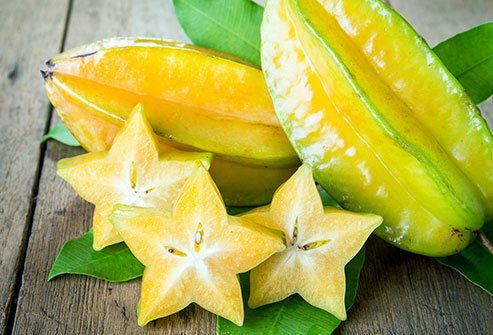Is Star Fruit Similar to Pineapple?

Star fruits and pineapples look and taste distinctly different.
- Star fruits are fleshy, crunchy, juicy, slightly tart, sweet, and acidic in taste.
- Pineapple has spiky and tough skin outside with yellow flesh inside that is both sweet and tart.
Both star fruits and pineapples are tropical fruits loaded with nutrients, vitamins, and minerals that offer numerous health benefits. While they share similar characteristics, view the differences between the two fruits below.
Differences between star fruits and pineapples
| Features | Star fruit | Pineapple |
|---|---|---|
| Appearance | Star-shaped, deeply ridged yellow-brown, edible fruit | Tropical fruit with spiky and tough skin outside with an appearance of a pinecone and has yellow flesh inside |
| Taste | Sweet, acidic, and slightly tart | Sweet and tart |
| Family | Oxalidaceae | Bromeliaceae |
| Native to | Malaysia and tropical America | Tropical and subtropical America |
| Commonly used |
In different food items, such as
|
As an ingredient in the meat, salads, smoothies, juices, vegetable, fish, and rice dishes |
| Health benefits |
|
|
What is a star fruit?
Star fruit, also called Averrhoa carambola, is a tropical fruit mainly found in India, Malaysia, Indonesia, and the Philippines.
| Stage | Firmness | Color |
|---|---|---|
| Young | Firm texture | 100 percent green |
| Half-ripe | Firm texture | Yellowish green |
| Ripe | Soft texture | 100 percent yellow |
The nutritional content of star fruit
Star fruits are loaded with nutrients and are good sources of fibers, several vitamins, minerals, and antioxidants.
| Mineral | Amount (mg/100 grams of fruit)* |
|---|---|
| Sodium (Na) | 3.8 to 3.85 |
| Potassium (K) | 167.13 to 168.0 |
| Calcium (Ca) | 6.37 to 6.40 |
| Phosphorous (P) | 17.87 to 17.88 |
| Magnesium (Mg) | 11.85 to 12.05 |
| Iron (Fe) | 0.34 to 0.45 |
| Copper (Cu) | 0.19 to 0.45 |
| Zinc (Zn) | 0.29 to 0.51 |
| Manganese (Mn) | 0.04 to 0.52 |
| Selenium (Se) | Not detectable |
| *Based on a dry weight | |
| Name | Amount (mg/100 grams of fruit)* |
|---|---|
| Carotene | 0.003 to 0.55 |
| Tartaric acid | 4.37 |
| Oxalic acid | 9.6 |
| Ketoglutaric acid | 2.2 |
| Citric acid | 1.32 |
| Vitamin B1 and B2 | 0.12 |
| Vitamin C | 25.8 |
| *Based on a dry weight | |
What is pineapple?
Pineapple is a tropical fruit native to South America but is grown worldwide, including in Thailand, the Philippines, and Brazil. It belongs to the bromeliad family and is the only member of that family that produces edible fruit.
The nutritional content of pineapple
Pineapple is loaded with minerals and vitamins. The active ingredient of pineapple, bromelain, is responsible for exhibiting various health benefits. Hence, bromelain supplements are used in the management of various medical conditions.
| Nutrient | Amount |
|---|---|
| Calories | 82 grams |
| Protein | 0.89 grams |
| Fat | 0.20 grams |
| Carbohydrates | 22 grams |
| Fiber | 2.3 grams |
| Calcium | 21.4 mg |
| Magnesium | 19.8 mg |
| Phosphorous | 13.2 mg |
| Potassium | 180 mg |
| Vitamin C | 78.9 mg |
The active ingredients of pineapple responsible for various health benefits include:
